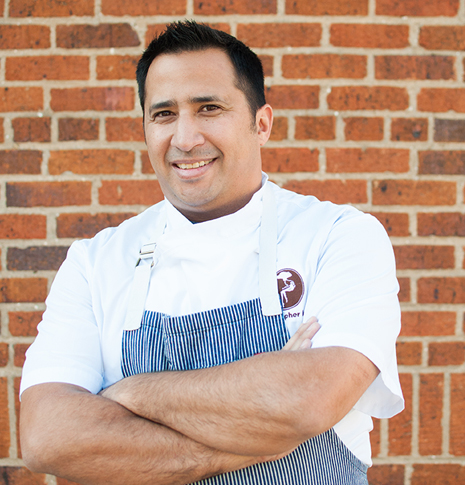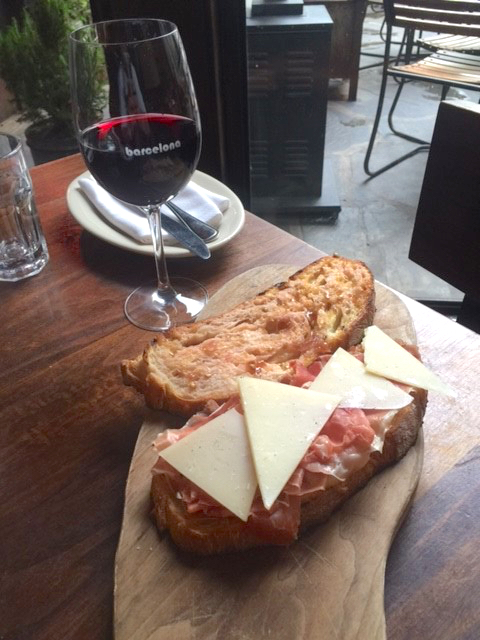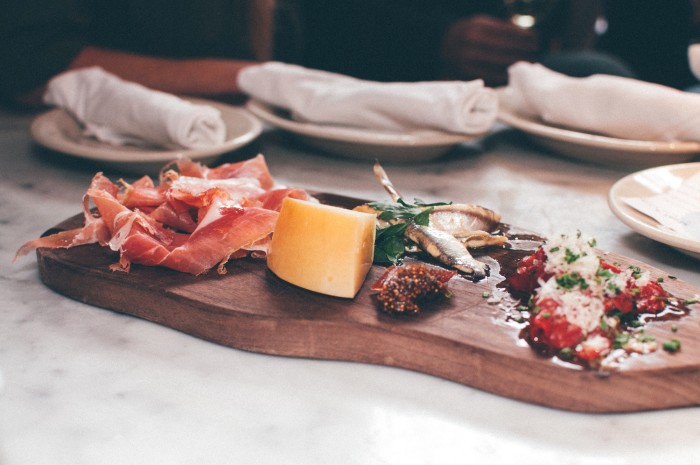Spanish Meats 101: Jamón, Salchichón And Chorizo With Christopher Lee
If you want to talk in depth about the European art of dry-cured meat —and really nerd out over nuances, densities and aging, among other things — pull up a bar stool next to chef Christopher Lee.
Having worked alongside industry masters Alfred Portale, Jean-Georges Vongerichten, Daniel Boulud and Charlie Palmer, Lee won the James Beard Award for Rising Star Chef in 2005 and earned two Michelin stars at NYC restaurant Gilt. Now the culinary director at award-winning Spanish tapas restaurant group Barcelona Wine Bar, Lee is perfecting the art of serving beautiful hams and sausages to ever-eager diners.
Grab your fancy ham-slicing knife and a glass of Tempranillo and gain some insight from a longtime champion of charcuterie.
Someone walks into Barcelona having never eaten Spanish charcuterie, hands you $50 and says, "School me." What kind of board do you make?
I would suggest several things. The high-end products are Ibérico bellota, ham cured on the leg sliced very thinly. You'll get that acorn flavor from the fat, and you're also going to get fresh and dry meat textures — an array of densities and flavors. The thigh protected by the leg fat tends to be a little more tender and fresher. We'd do a side-by-side tasting of the jamón with salchichón Ibérico. So you'd taste the Ibérico neat, then taste it alongside the cured sausage from the salami world, both with that same acorn-based nuttiness.
We'd also add some Serrano ham, which tends to have more of a prosciutto texture with both fresh and cured ham flavors. The fat's nice and moist, and you'll see the difference in textures between that and the Ibérico bellota, which is carved off the leg. I'd round it off with two types of sausages: a dry-cured, and one that's a little more textural. Chorizo picante tends to be a really skinny, hard dry-cured sausage with smoked paprika, garlic and pimentón. And fuet is another style, more like a common dry salami, but texturally very clean with just black peppercorns.
And finally, some Ibérico lomo — the entire loin, rubbed with spices, soft cured and sliced razor-thin so it just melts on your palate. Ibérico lomo will have that same iconic acorn-based nutty flavor to it. That's an intense Spanish-driven charcuterie board.
What would you pour for this decked-out charcuterie board?
I would enjoy a lighter-style red wine — a Tempranillo would be great. You're looking to get into the French world, I'd say pinot noir, and if you're going for Italian I'd say Barbaresco. Those are all more refreshing; you don't want a Super Tuscan, a cab or a heavy merlot, but something a little more fluid where the body's not so rich.
What's different about the way Spanish people make charcuterie than, say, the Italians or French?
The difference in the cured products of the Spaniards would be the spice flavorings. You'll see a lot of pimentón, sweet paprika and garlic — they love garlic. Spanish hams go through a salting process for 24 hours, then a moist dry phase and a dry phase. You impart a lot of flavor from that salt-curing process. The French use a lot more black pepper; the Italians like fennel and herbs. That's the big difference — they concentrate more on the spices they add.
Which element of the board do you feel most closely connected to, and why?
I love the hams cured on the bone. We serve two types, the Ibérico bellota and the Mangalitsa. Mangalitsa tends to be aged three to four years, and the bellota for six to eight years. They're truly amazing, and I would eat that all day, every day, for the rest of my life if I wouldn't die from the cholesterol. That's my true romance.
I first went to Spain in 2004 with Alfred Portale for the Madrid Fusion Conference. He took me to help him with the demonstration. I was introduced to the Ibérico ham, and I ate it every day for breakfast, lunch and dinner. I had to bring it back, because in 2004 you couldn't get it in the U.S. and I wanted all my cooks back in Philly to try it, so I got some jamón, sliced it, Cryovac'd it and shoved it between my dirty clothes in my suitcase. It took me about a half a day to plan it out, slice and pack it all up. I just had ham stuffed in all my socks and shirts and everything. I was lucky that customs didn't look through my bag. They would have thrown it all away, laughing.
Jamón is so ubiquitous and widely consumed in Spain that even working-class families will buy a whole leg and slice pieces off whenever they like. Why are we not doing that?
It's the FDA: The guidelines and rules they're putting on producers and companies really prevent it. If a company imports to the U.S., there's a seven-year waiting list to make totally sure there's no listeria in their product. Every time I've gone to Spain, I've had the pleasure of talking to ham producers. A Spanish producer could be operating for 100 years with no listeria whatsoever, but the FDA says the waiting list ensures you won't have listeria entering the country. These legs I'm talking about, they're sitting in warehouses in temperature-controlled rooms for two years! When they're done curing, you can keep them on your counter for three months. I've had a leg on my counter for three weeks, and it's perfectly fine. I posted it on Facebook, and all my neighbors came over — it's a communal, fun thing.
We put a lot of rules and regulations in our food. Go to Europe, and you won't find butter and eggs in a fridge. Granted, the eggs are fresh, and when they're fresh you don't have to fridge 'em. But I've never gotten sick overseas from charcuterie.
It seems like Europeans find more pleasure in making and eating charcuterie than we do.
For them, it's something that induces beautiful memories; it's something you've shared with family for years. There's a very strong tie you see when chefs, especially chefs from Europe, get their hands on something they ate as children. They get into that phase of "Oh, this is my grandmother's recipe" or "We served this in Lyon, and I never found it again."
When I worked at Daniel, [chef Daniel Boulud's] father cured hams in their basement [at home]. [Boulud] didn't return to France for a while, then his father shipped him one of those cured legs. He broke it out in the kitchen and was totally giddy for the next week eating that ham he remembered from growing up. It's a beautiful technique, it's not easy to do, and that's why not many people do it, because of the high risk factor. You see the culinary community getting larger, but culinarians talking about classic technique is fading fast. They know the avant-garde stuff, but if you ask them to make a classic terrine they're like, "What?"
What do you have to say to people who think old moldy hams chilling in a warehouse are gross?
If it's not the white-induced mold, it is gross. It should never be moist, furry or anything like that. And to each their own — I never try to convince anybody to try anything they don't want to, but I do assure them it's perfectly fine. I saw on Facebook that someone left a McDonald's burger on a counter for seven years, and it didn't go rancid because it was so overcooked and dried out that there was nothing for bacteria to grow on. Not to make that comparison or anything, but when you dry-cure with good ventilation, you'll be fine.




